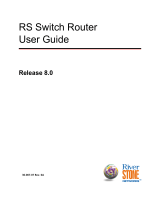
SG2122-2
Design Challenges
CMTS equipment vendors are under
tremendous pressure to support an
expanded level of functionality while
adapting to evolving standards and new
application requirements. The CMTS
serves as the backbone of the HFC
network, bridging WAN interfaces with
RF-based cable modems typically built
around Data Over Cable Service
Interface Specification (DOCSIS®)/
EuroDOCSIS. The evolution of DOCSIS
standards has added Quality of Service
(QoS) functionality in order to support
real-time applications such as IP
telephony. This requires CMTS to
support classification and traffic
management on many thousands of
flows. Continued DOCSIS evolution is
increasing the bidirectional bandwidth
and QoS requirements of these systems.
The headend equipment also requires a
full array of WAN interface support,
including varieties of Ethernet, SONET,
and ATM. Additionally, with fiber
installations moving closer and closer to
the end-users, CMTS functionality is
migrating outside the headend to the
neighborhood nodes. This constrains
system power and cost budgets and
imposes stricter requirements on the
mechanical and environmental aspects
of the design.
This combination of protocol evolution
and diversity, higher performance, and
advanced QoS requirements makes
CMTS equipment design challenging,
especially when combined with the cost
and time-to-market pressures of today's
market. No longer adequate are the
traditional design approaches where
each interface line card is implemented
using a separate set of application
specific integrated circuits (ASICs) or
application specific standard products
(ASSPs). With the trend toward more
distributed implementations, a “platform”
approach to design, where the same
software can be leveraged everywhere
from the distribution points to the cable
headend, offers significant benefits.
Freescale Semiconductor Solution
Freescale Semiconductor’s C-Port™
Network Processor (NP) family brings
the high-service, high-functionality
requirements of the CMTS together in a
highly integrated silicon solution. Perfect
for both high-end headend or power/
cost-sensitive industrial temperature
environments, the C-Port NP family is
well suited to serve as a base
architectural platform for CMTS
equipment applications.
The C-Port network processor is
distinguished from other NPs by its fully
software-programmable Layer 2
interfaces. This makes it capable of
supporting virtually any L2 protocol,
including Ethernet, SONET, and even
DOCSIS implementations. Further, as
protocols evolve, the NPs can be
reprogrammed in software to support
new requirements. The C-3e NP, with up
to 3 Gbps bandwidth, is aimed at lower
bandwidth applications such as HFC
distribution nodes, while the C-5e NP,
with up to 5 Gbps bandwidth, is well
suited for headend use. In addition to the
L2 protocol programmability, C-Port NPs
support higher-level programming in C-
language, enabling fast development of
advanced features by which equipment
vendors may differentiate their products
from the competition.
With so much flexibility, a single line card
can be designed to interface to
numerous types of PHY modules. This
greatly simplifies system architecture
because nearly every interface that a
CMTS needs to support can be based on
a common hardware platform.
Traffic classification is performed in the
on-chip Table Lookup Unit, which
performs up to 133M lookups/sec. Flows
are organized in the Queue
Management Unit (QMU), which
provides application support for 512
queues. Traffic management functions
can be scaled to much greater
sophistication with the addition of the
C-Port Q-5 Traffic Management
Coprocessor (TMC), supporting up to
256k independent queues and a
powerful three-level scheduling
hierarchy. The Q-5 supports policing,
monitoring, and shaping of 256k unique
flows, and offers up to 4K virtual
channels with multiple QoS levels per
virtual channel. On a CMTS line card,
each virtual channel may be assigned to
a different downstream destination,
enabling true multiservice access. The
Q-3 TMC is also available, which
provides 64k independent queues and
addresses power and cost-sensitive
applications.
The C-Port family of network processors
and traffic managers share an
architecturally unified C-language
application programming interface (API)
that abstracts chip subsystems, allowing
your application to migrate easily to
future generations of C-Port network
processing silicon.
Freescale Ordering Information
Part Number Product Highlights Additional Information
PCC3E0RX180WA0A 5.5W @ 180 MHz www.freescale.com/networkprocessors
PCC5E0RX266WA0A 9W @ 266 MHz www.freescale.com/networkprocessors
PCQ300ZPWA0A 3W @ 100 MHz www.freescale.com/networkprocessors
PCQ500ZPTA0A 4.5W @ 133 MHz www.freescale.com/networkprocessors
MPC7410 Performs control plane processing within the CMTS www.freescale.com/PowerPC




